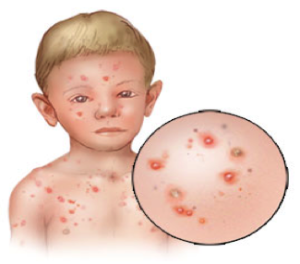CHICKENPOX
About chickenpox
Chickenpox is a common childhood skin disease caused by a virus. The virus is called the varicella-zoster virus.
It is a common illness among kids, particularly those under the age of 12. An itchy rash of spots that look like blisters can appear all over the body and be accompanied by flu-like symptoms. Symptoms usually go away without treatment, but because the infection is very contagious, an infected child should stay home and rest until the lesions are scabbed over and dry.
How does chickenpox spread?
Chickenpox is contagious disease. It is easily passed between members of families and school classmates through airborne particles, droplets in exhaled air and fluid from the blisters or sores. It also can be transmitted indirectly by contact with articles of clothing and other items exposed to fresh drainage from open sores. Patients are contagious up to five days (more commonly, one to two days) before and five days after the date that their rash appears. When the sores have crusted over, the person is usually no longer contagious.
Symptoms
Chickenpox causes a red, itchy skin rash that usually appears first on the abdomen or back and face, and then spreads to almost everywhere else on the body, including the scalp, mouth, nose, ears, and genitals.

The rash begins as multiple small red bumps that look like pimples or insect bites. They develop into thin-walled blisters filled with clear fluid, which becomes cloudy. The blister wall breaks, leaving open sores, which finally crust over to become dry, brown scabs.
Chickenpox blisters are usually less than a quarter of an inch wide, have a reddish base, and appear in crops over 2 to 4 days. The rash may be more extensive or severe in kids who have skin disorders such as eczema.
Some kids have a fever, abdominal pain, sore throat, headache, or a vague sick feeling a day or 2 before the rash appear. These symptoms may last for a few days, and fever stays in the range of 100°–102° F (37.7°–38.8° C), though in rare cases may be higher. Younger kids often have milder symptoms and fewer blisters than older children or adults.
Treatment
Most of the treatments for chickenpox are aimed at decreasing the symptoms, such as severe itching. Acetaminophen (Tylenol) or Paracetamol can be used to decrease the fevers and aches often associated with the initial presentation of the viral infection. A virus causes chickenpox, so the doctor won’t prescribe antibiotics. However, antibiotics may be required if the sores become infected by bacteria. This is pretty common among kids because they often scratch and pick at the blisters.
The antiviral medicine acyclovir may be prescribed for people. The drug, which can make the infection less severe, must be given within the first 24 hours after the rash appears. Acyclovir can have significant side effects, so it is only given when necessary. Your doctor can tell you if the medication is right for your child.
Keeping children away from School or Childcare
A child should be kept at home for 5 days after the first spots appear, or until all blisters are dry if this takes longer. Some scabs will still be there but as long as they are dry the child does not need to be kept out of school, or away from others.
Dealing with Discomfort
To help relieve the itchiness, fever, and discomfort of chickenpox:
- Use cool wet compresses or give baths in cool or lukewarm water every 3 to 4 hours for the first few days. (Baths do not spread the rash.)
- Pat (don’t rub) the body dry.
- Put calamine lotion on itchy areas (but don’t use it on the face, especially near the eyes).
- Serve foods that are cold, soft, and bland because chickenpox in the mouth may make drinking or eating difficult. Avoid feeding your child anything highly acidic or especially salty, like orange juice or pretzels.
- Ask the doctor about using over-the-counter medication for itching.
- Anti histamine medicines can help with the itch. Talk to your doctor about this.
Never use aspirin to reduce pain or fever in kids with chickenpox because aspirin has been associated with the serious disease Reye syndrome, is a rare illness causing severe damage to the brain and liver, and it is often fatal even when the child is given intensive care.
As much as possible, discourage kids from scratching. This can be difficult for them, so consider putting mittens or socks on your child’s hands to prevent scratching during sleep. In addition, trim fingernails and keep them clean to help lessen the effects of scratching, including broken blisters and infection.
Immunisation
- It is recommended in Australia that children be immunized against chicken pox when they are 18 months old and when they are in Year 8.
- The vaccine is also particularly recommended for people in ‘high risk’ jobs such as health care, child care and teachers. Also for non-immune women before pregnancy and non-immune family members of people with immune system disorders. The vaccine may not be free for these people.
- The vaccine should not be given during pregnancy, however no problems have occurred yet when women have been given the vaccine accidentally while pregnant.
- Some people may still catch chickenpox after immunisation (only about 70% to 90% of people get fully protected), but the illness will be milder than if no immunisation had been given.
- Side effects are uncommon in healthy people. About 20% of children and adults will get some soreness at the site of the injection, 5% or less will get some fever and less than 5% will get a rash.
www.medicinenet.com, kidshealth.org
